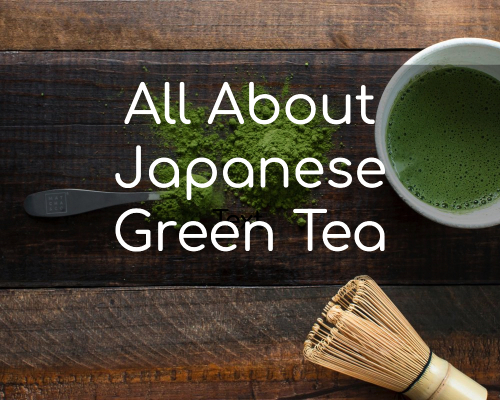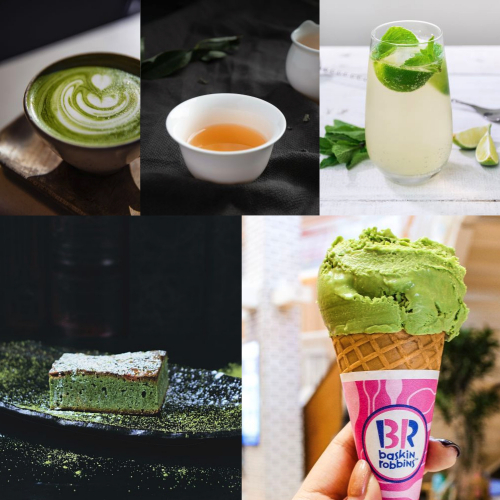Looking to learn a bit about Japanese Green Tea?
In this guide, you’ll learn the following:
- Intro to Green Tea
- Green Tea Types & Their Benefits
- Green Tea Brands
So, let’s jump in.

1) Intro to Japanese Green Tea
Of all the different types of Japanese tea out there, green tea is the most common one — so let’s talk about it.
Green tea is a type of tea with a very distinct green color and earthy taste. It’s mostly made from a special type of evergreen bush. And this bush can be processed in different ways to make different types of green tea. Green tea can either be steeped in hot water or cold brewed, to suit different people’s tastes.
So, how did Japanese Green Tea come to be? Green tea came to Japan from China around the 9th century. Back then, it was a beverage for Japanese priests. But since then, it has become an important part of Japanese people’s lives and Japanese culture.

You can now find green tea in all shapes and forms: traditional brewing methods, desserts, bottled drinks, and cuisine.
And yes, even the green tea Kit Kat.
When do people drink it? It’s common in Japan to drink green tea all day long. Many households will have a water boiling pot that has constant hot water… or even special Japanese teapots. Why?So you can make green tea from morning to night. It’s most popular to drink with meals, snacks, and when guests are visiting. You’ll also notice that sushi restaurants serve green tea with sushi. There is also a popular late night dish called ochazuke (a unique Japanese food), where tea is poured on top of rice with different ingredients.
Now, what are the Japanese green tea benefits? You’ll learn down in the next part — the types of green teas.
2) Japanese Green Tea Types & Benefits
Now that you know a bit about green tea, let’s talk about types. Remember, there are many ways to process the tea leaves which results in different types of teas. You can also find these teas on Amazon (Amazon affiliate links below) if you’re Interested.
2.1 Sencha – Steeped green tea
- Benefits: Good for weight loss, anti aging, and antibacterial properties.
- Taste: Rich in umami (umami is a pleasant savory taste).
Sencha is the most standard type of Japanese green tea that people drink. It’s made through a process of steaming and rolling the leaves before it’s dried. Although other Asian countries also produce green tea, the Japanese process creates a special flavor that is rich in umami. The flavors of sencha goes well with different types of Japanese foods and sweets.
2.2 Shincha – Freshly picked green tea
- Benefits: Less caffeine and higher vitamin content.
- Taste: A sweet and mild taste.
The tea from the first harvest of the season is called Shincha. “Shin” means new in Japanese. And “cha” means tea. With green tea, the timing of the harvest can produce different effects on the flavor. Shincha is characterized by a sweet and mild taste. The earlier harvest produces a tea that is slightly lower in caffeine content.
2.3 Gyokuro – Shaded green tea
- Benefits: Good for mental focus, heart health, and healthy skin.
- Taste: Extremely sweet.
Gyokuro is a type of green tea where the leaves are grown under a shade for 3-4 weeks. The taste is extremely sweet and the amount of caffeine is higher than standard sencha. It is the most luxurious green tea because of its complex and delicate flavors.
2.4 Matcha – Powdered green tea
- Benefits: Contains full nutrients from the tea leaf and easy to prepare.
- Taste: Strong, rich, and intense. A green tea version of espresso.
In Japan, matcha is a special tea that is associated with Japanese tea ceremonies. Unlike other green teas, it is a tea that is formed into a powder. The flavors can be strong, rich, and intense. It is similar to the green tea version of espresso. Traditionally, it is served by whisking the powder with hot water and served with sugary sweets. Recently, matcha has experienced a widespread boom all over the world and it can be found as an ingredient in lattes, iced drinks, and western desserts.
2.5 Hojicha – Roasted green tea
- Benefits: Good for a stronger immune system and for those who can’t tolerate high amounts of caffeine.
- Taste: Roasted taste and smoky aroma.
Instead of being steamed, hojicha goes through a process where the tea is roasted. It is a way for reviving green tea that typically wouldn’t be a high-grade tea. Most teas that become hojicha are from the last harvest of the season. When the tea is roasted, the tea gains more flavor and a smoky aroma. Caffeine content is less than other green teas, so it is a great bedtime tea.
2.6 Genmaicha – Brown rice green tea
- Benefits: Good for heart health and managing blood sugar levels.
- Taste: Roasted.
Genmaicha is what you get when you mix sencha with roasted brown rice. The mixture of rice into the tea was a way to make it more affordable in the past. These days, it has gained popularity for its unique roasted taste and mild flavors.
3) Japanese Green Tea Brands
Now, if you wanted to get some green tea, which brands should you look for? Take a look below. You can find all of these on Amazon (affiliate links to Amazon below).
1. Ito-en
This is a widely accessible green tea brand that has teabags and bottled teas. The tea bags have a wide range of variety from special triangular shaped ones to tea bags blended with matcha powder. It’s an affordable and convenient option for enjoying green tea
2. Yamasan
A kyoto-based company, Yamasan produces a Japanese certified organic green tea. They make sure to test the tea of any harmful chemicals and microorganisms. They offer different types of green tea, for all of your needs.
3. Maeda-en
This company has brought Japanese green tea into the west by making it more friendly for western consumers. They have produced green tea ice creams, lattes, and mochi ice cream. Maeda-en is also a solid green tea brand if you’re looking for a traditional experience. They directly import tea from Japan at least once a month and have a constant line-up of different grades of green tea as well as tea bags.
4. Kimikura
Kimikura green tea is grown in Shizuoka prefecture, and comes straight from the farm. Their teas are certified organic and they do not use pesticides and synthetic fertilizers. They have a wide variety of green teas such as a sakura cherry blossom tea.
5. Ocha and Co
This is an award winning tea brand which has won the 56th national tea tasting competition. Their green tea comes straight from hillside farms in Japan. Each package is vacuum sealed to insure freshness.
Conclusion – Over to You
Now you know a bit about Japanese green tea, the brands, and the types of Japanese green tea… like Matcha and Hojicha.
Which is your favorite?
Leave a comment!
Relevant article:







If you are a tea or coffee addict & drink more than five cups of it a day while working in your office & need some health replacement for your caffeine & toxin needs than green tea is an ultimate solution to your problem.
[…] see Japanese green tea as either loose leaf teas or in a powder form. The tea leaves are generally processed by steaming, […]
[…] Japanese Green tea is the most popular tea in Japan and an ingredient you may find in some Japanese skincare products. The catechin found in green tea can help to reduce inflammations in the skin. […]